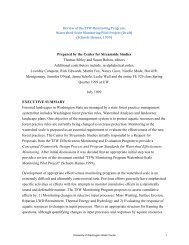Copyright 2012 Aileen M. Echiverri-Cohen - University of Washington
Copyright 2012 Aileen M. Echiverri-Cohen - University of Washington
Copyright 2012 Aileen M. Echiverri-Cohen - University of Washington
You also want an ePaper? Increase the reach of your titles
YUMPU automatically turns print PDFs into web optimized ePapers that Google loves.
Lavie et al., 2004; Vogel, Woodman, & Luck, 2005), with early-stage perceptual factors and<br />
late-stage central capacity limitations both modulating AB.<br />
Overall, AB measures the ability to direct attention to multiple stimuli and assesses<br />
temporal cognitive processing, providing a solid cognitive index <strong>of</strong> inhibitory processing. AB<br />
has not been examined in PTSD. Yet, there is evidence <strong>of</strong> AB deficits in disorders including<br />
schizophrenia (Li, Lin, Yang, Huang, Chen, & Chen, 2002; Wynn, Breitmeyeer, Nuechterlein, &<br />
Green, 2006), attention deficit hyperactivity disorder (Armstrong & Munoz, 2003;<br />
Hollingsworth, McAuliffe, & Knowlton, 2001; Li, Lin, Chang, & Hung, 2004; Mason,<br />
Humphrey, & Kent, 2005), and dysphoric mood (Rokke, Arnell, Koch, & Andrews, 2002).<br />
These studies typically show a deep, protracted u-shaped curve, suggesting a slower recovery<br />
from the impairment in attention that may result from limited attentional resources.<br />
Similarly, inhibitory processes that drive AB may be related to those influencing prepulse<br />
inhibition <strong>of</strong> startle (PPI; Filion, Kelly, & Hazlett, 1999). PPI is a form <strong>of</strong> startle modulation<br />
which occurs when a non-startling prepulse precedes the startling pulse by a short interval (e.g,<br />
30 - 120 ms), resulting in inhibition <strong>of</strong> the startle reflex (Blumenthal, 1999). PPI is thought to<br />
occur through a sensorimotor gating system that functions as an attentional filter to protect<br />
limited capacity systems from being overloaded with incoming sensory information (Graham,<br />
1975). PPI is proposed to index early stages <strong>of</strong> lower level, automatic processing and voluntary,<br />
controlled, attentional processing. These levels <strong>of</strong> processing follow different time courses, such<br />
that automatic processing occurs before 120 ms (Wu, Krueger, Ison, & Gerrard, 1984; Wynn ,<br />
Schell, & Dawson, 1996), whereas controlled processing occurs at or after 120 ms (Blumenthal,<br />
1999; Dawson, Hazlett, Filion, Nuechterlein, & Schell, 1993; Filion et al., 1999). Greater PPI is<br />
presumed to be associated with more effective information processing (e.g., Bitsios,<br />
9
















